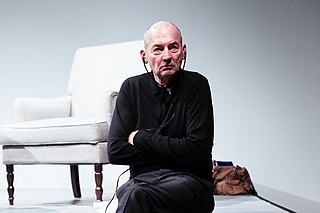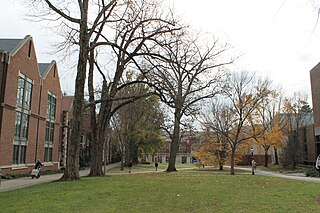Related Research Articles

Remment Lucas Koolhaas is a Dutch architect, architectural theorist, urbanist and Professor in Practice of Architecture and Urban Design at the Graduate School of Design at Harvard University. He is often cited as a representative of Deconstructivism and is the author of Delirious New York: A Retroactive Manifesto for Manhattan.

The Guggenheim Museum Bilbao is a museum of modern and contemporary art designed by Canadian-American architect Frank Gehry, and located in Bilbao, Basque Country, Spain. The museum was inaugurated on 18 October 1997 by King Juan Carlos I of Spain, with an exhibition of 250 contemporary works of art. Built alongside the Nervion River, which runs through the city of Bilbao to the Cantabrian Sea, it is one of several museums belonging to the Solomon R. Guggenheim Foundation and features permanent and visiting exhibits of works by Spanish and international artists. It is one of the largest museums in Spain.

The Solomon R. Guggenheim Museum, often referred to as The Guggenheim, is an art museum at 1071 Fifth Avenue between 88th and 89th Streets on the Upper East Side of Manhattan in New York City. It is the permanent home of a continuously expanding collection of Impressionist, Post-Impressionist, early Modern, and contemporary art and also features special exhibitions throughout the year. The museum was established by the Solomon R. Guggenheim Foundation in 1939 as the Museum of Non-Objective Painting, under the guidance of its first director, Hilla von Rebay. The museum adopted its current name in 1952, three years after the death of its founder Solomon R. Guggenheim.

The Solomon R. Guggenheim Foundation is a nonprofit organization founded in 1937 by philanthropist Solomon R. Guggenheim and his long-time art advisor, artist Hilla von Rebay. The foundation is a leading institution for the collection, preservation, and research of modern and contemporary art and operates several museums around the world. The first museum established by the foundation was The Museum of Non-Objective Painting, in New York City. This became The Solomon R. Guggenheim Museum in 1952, and the foundation moved the collection into its first permanent museum building, in New York City, in 1959. The foundation next opened the Peggy Guggenheim Collection in Venice, Italy, in 1980. Its international network of museums expanded in 1997 to include the Guggenheim Museum Bilbao in Bilbao, Spain, and it expects to open a new museum, Guggenheim Abu Dhabi, in the United Arab Emirates after its construction is completed.

Graduate School of Architecture, Planning and Preservation (GSAPP) is the architecture school of Columbia University, a private research university in New York City. It is regarded as an important and prestigious architecture school. It is also home to the Masters of Science program in Advanced Architectural Design, Historic Preservation, Real Estate Development, Urban Design, and Urban Planning.
Venice Biennale of Architecture is an international exhibition of architecture from nations around the world, held in Venice, Italy, every other year. It was held on even years until 2018, but 2020 was postponed to 2021 due to the COVID-19 pandemic shifting the calendar to uneven years. It is the architecture section under the overall Venice Biennale and was officially established in 1980, even though architecture had been a part of the Venice Art Biennale since 1968.

Carlo Ratti is an Italian architect, engineer, inventor, educator and activist. He is a professor at the Massachusetts Institute of Technology where he directs the MIT Senseable City Lab, a research group that explores how new technologies are changing the way we understand, design and ultimately live in cities. Ratti is also a founding partner of the international design and innovation office CRA-Carlo Ratti Associati, which he established in 2004 in Torino, Italy, and now has a branch in New York City, United States. Ratti was named one of the "50 most influential designers in America" by Fast Company and highlighted in Wired magazine's "Smart List: 50 people who will change the world".

The MIT School of Architecture and Planning is one of the five schools of the Massachusetts Institute of Technology, located in Cambridge, Massachusetts. Founded in 1865 by William Robert Ware, the school offered the first formal architectural curriculum in the United States, and the first architecture program in the world operating within the establishment of a university. MIT SAP is considered a global academic leader in the design field and one of the most accomplished schools in the world. MIT's department of architecture has consistently ranked among the top architecture/built environment schools in the world, and from 2015 to 2018 was ranked highest in the world in QS World University Rankings. In 2019, it was ranked second to The Bartlett but regained the number one position later on in the 2020 rankings.

The Guggenheim Abu Dhabi is a planned art museum, to be located in Saadiyat Island cultural district in Abu Dhabi, United Arab Emirates. Upon completion, it is planned to be the largest of the Guggenheim museums. Architect Frank Gehry designed the building. After announcing the museum project in 2006, work on the site began in 2011 but was soon suspended. A series of construction delays followed; the museum is expected to be completed in 2025.

Thomas Krens is the former director and Senior Advisor for International Affairs of the Solomon R. Guggenheim Foundation in New York City. From the beginning of his work at the Guggenheim, Krens promised, and delivered, great change, and was frequently in the spotlight, often as a figure of controversy.

The Deutsche Guggenheim was an art museum in Berlin, Germany, open from 1997 to 2013. It was located in the ground floor of the Deutsche Bank building on the Unter den Linden boulevard.
The MIT Senseable City Laboratory is a digital laboratory within MIT's City Design and Development group, within the Department of Urban Studies and Planning, which works in collaboration with the MIT Media Lab. The lab aims to investigate and anticipate how digital technologies are changing the way people live and their implications at the urban scale.
Zaha Hadid Architects is a British architecture and design firm founded by Zaha Hadid (1950–2016), with its main office situated in Clerkenwell, London.

Guggenheim Helsinki Plan was an initiative to establish a Guggenheim museum in Helsinki, Finland. A proposal was introduced to the Helsinki City Council in 2011. After rejection of the initial plan in 2012, a new plan, introduced in 2013, was considered and finally rejected in 2016.

Richard Armstrong is an American museum director. Since 2008, Armstrong has been the director of the Solomon R. Guggenheim Foundation, including the Solomon R. Guggenheim Museum in New York City and its other museums throughout the world. Before joining the Guggenheim, he was a curator at, and then director of, Carnegie Museum of Art in Pittsburgh, Pennsylvania. From 1981 to 1992, he had been a curator at the Whitney Museum of American Art.

Matthew Joseph Williams Drutt is an American curator and writer who specializes in modern and contemporary art and design. Based in New York, he has owned and operated his independent consulting practice Drutt Creative Arts Management (DCAM) since 2013l. He is currently working with the Nationalmuseum Stockholm on an exhibition and publication of modern and contemporary American crafts gifted from artists and collectors in the United States to the museum, originally organized by his mother, Helen Drutt. He has worked more recently with the Eckbo Foundation in Oslo on the first major monograph of Thorwald Hellesen published in English and Norwegian in by Arnoldsche Art Publishers. He is currently also developing several other titles with the publisher. Formerly, he worked with the Beyeler Foundation in Switzerland (2013–2016) and the State Hermitage Museum in Russia (2013–2014), consulting on exhibitions, publications, and collections. He continues to serve as an Advisory Curator to the Hermitage Museum Foundation Israel. In 2006, the French Government awarded him the Chevalier de l'Ordre des Arts et des Lettres, and in 2003, his exhibition Kazimir Malevich: Suprematism won Best Monographic Exhibition Organized Nationally from the International Association of Art Critics.
Alexandra Munroe, Ph.D., is a curator, Asia scholar, and author focusing on art, culture, and institutional global strategy. She has produced over 40 exhibitions and published pioneering scholarship on modern and contemporary Asian art. She organized the first major North American retrospectives of artists Yayoi Kusama (1989), Daido Moriyama (1999), Yoko Ono (2000), Mu Xin (2001), Cai Guo-Qiang (2008), and Lee Ufan (2011), among others, and has brought such historic avant-garde movements as Gutai, Mono-ha, and Chinese conceptual art, as well as Japanese otaku culture, to international attention. Her project Japanese Art after 1945: Scream Against the Sky (1994) is recognized for initiating the field of postwar Japanese art history in North America. Recently, Munroe was lead curator of the Guggenheim’s exhibition, Art and China after 1989: Theater of the World, which the New York Times named as one of 2017’s top ten exhibitions and ARTnews named as one of the decade’s top 25 most influential shows. Credited for the far-reaching impact of her exhibitions and scholarship bolstering knowledge of postwar Japanese art history in America and Japan, she received the 2017 Japan Foundation Award and the 2018 Commissioner for Cultural Affairs Award, both bestowed by the government of Japan.

Princeton University School of Architecture is the name of the school of architecture at Princeton University. Founded in 1919, the School is a center for teaching and research in architectural design, history, and theory. The School offers an undergraduate concentration and advanced degrees at the master's and doctoral levels.

Anna Sokolina, PhD is an American architect, scholar, and curator, Routledge featured author, founding chair of Women in Architecture Affiliate Group of the Society of Architectural Historians (SAH) and of SAH WiA AG Legacy Committee, founder and co-chair of SAH WiA AG Registers Committee, Advisory Board member of The Bloomsbury Global Encyclopaedia of Women in Architecture, of ARTMargins, and of H-SHERA Network, and honorary advisor elected in 2002 to International Archive of Women in Architecture Board of Advisors.
References
- ↑ McHugh, Sharon. "BMW Guggenheim Lab to Launch in NYC", World Architecture News, May 17, 2011, accessed January 23, 2012
- 1 2 Vogel, Carol. "BMW Ends Support for Guggenheim Lab Project", The New York Times, July 2, 2013
- 1 2 Carol Vogel, "A Lab on a Mission", The New York Times, May 6, 2011
- 1 2 "Six-Year Collaboration to Examine Contemporary Urban Issues in Nine Cities Around the World – International Advisory Committee Selects New York BMW Guggenheim Lab Team – Design of First Mobile Laboratory", Associated Press, May 6, 2011
- ↑ "BMW Guggenheim Lab to Launch in New York City on August 3 Before Traveling to Berlin and Asia" Archived 2012-01-25 at the Wayback Machine , Guggenheim Foundation, May 6, 2011, accessed January 23, 2012
- 1 2 3 Vogel, Carol. "Urban Lab Heads East", The New York Times, October 27, 2011, accessed January 23, 2012
- ↑ "What Is the Lab?", The Solomon R. Guggenheim Foundation. Retrieved April 9, 2012
- ↑ Boscawen, Rosanna. "Confronting Comfort at the BMW Guggenheim Lab", The New York Observer, August 8, 2011
- ↑ "People", BMW Guggenheim Lab, accessed January 9, 2022
- ↑ [https://www.dexigner.com/news/23016 "BMW Guggenheim Lab to Launch in New York City", Dexigner, May 9, 2011
- ↑ "Following Threats, BMW Guggenheim Lab Finds a New Berlin Location", The Atlantic Cities, April 3, 2012
- ↑ "BMW Guggenheim Lab Berlin to Open in May 2012", Dexigner, November 9, 2011, accessed January 23, 2012
- ↑ The BMW Guggenheim Lab Gets a Mumbai Makeover, Artinfo.com, October 22, 2012
- ↑ "BMW Guggenheim Lab to Launch in Mumbai", Architizer.com, accessed October 24, 2012
- ↑ BMW Guggenheim Lab Mumbai to Open December 9, 2012 Archived October 24, 2012, at the Wayback Machine , UnitedNetworker.com, October 22, 2012
- ↑ Six designs selected as solutions for congested Kala Nagar junction, Times of India, January 18, 2014
- ↑ BMW Guggenheim Lab Comes to an Early End, Architectural Record, October 17, 2013.